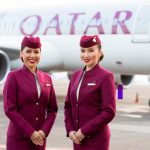The Middle East is an “essential pillar” of Philippine Airlines’ global strategy, with plans to strengthen the carrier’s footprint across the region.
In an interview with Rihlat Travel News, Josh Vasquez, the airline’s Regional Sales Head, EMEA, said market demand between the Philippines and the Middle East is strong, particularly amongst the growing leisure and business market.

“The UAE remains our strongest performer, with consistently high demand from Dubai and the other emirates. We’re also seeing a resurgence in demand from Saudi Arabia,” Vasquez said. “Filipino overseas workers, visiting friends and relatives (VFR), and an increasing number of GCC-based travelers exploring the Philippines as a holiday destination are all key drivers of this demand.”
To keep up with demand, Philippine Airlines (PAL) is looking to launch new flights across the region, including a new nonstop between Manila and Doha starting next month.
Read the full interview below for more on PAL’s plans in the Middle Eastern region:
How has Philippine Airlines’ presence in the Middle East evolved over the past few years?
Over the past few years, PAL has steadily rebuilt and expanded its Middle East network following the pandemic. We’ve resumed key routes and adjusted capacity based on market demand and operational feasibility. Our primary focus has been reconnecting with the large Filipino diaspora, while also tapping into the growing interest in leisure and business travel between the Philippines and the Gulf.
What routes or services are you seeing the strongest demand for out of this region?
The UAE remains our strongest performer, with consistently high demand from Dubai and the other emirates. We’re also seeing a resurgence in demand from Saudi Arabia. Filipino overseas workers, visiting friends and relatives (VFR), and an increasing number of GCC-based travelers exploring the Philippines as a holiday destination are all key drivers of this demand.
Are there any new route launches, frequency increases, or fleet updates planned for the Middle East market?
We’re continually evaluating route and frequency adjustments based on passenger trends and fleet availability. For the next year, we will continue to operate our daily Riyadh and Dubai flights.
Starting 16 June 2025, PAL will launch daily nonstop flights between Manila and Doha as part of a strategic partnership with Qatar Airways. The agreement includes a codeshare, with Qatar Airways placing its code on PAL’s seven weekly flights.
This partnership enhances connectivity for travelers from the Philippines to over 170 global destinations via Doha, leveraging seamless transfers at Hamad International Airport—Skytrax’s 2025 Best Airport in the Middle East.
How does the Middle East fit into the airline’s global growth and connectivity plans?
The Middle East is an essential pillar of PAL’s global strategy, given the sizeable Filipino population and the region’s role as a gateway to Africa and Europe. We see the region not just as a source market, but also as a transit point with opportunities for expanded connectivity through codeshare and interline partnerships. Strengthening our presence here helps reinforce PAL’s position as the Philippines’ premier flag carrier with a truly global reach.
What are some of the key factors that drive PAL’s strategy in this region?
Our strategy is anchored on three main pillars: demand from the Overseas Filipino Worker (OFW) market, growing tourism interest in the Philippines, and strong bilateral ties between the Philippines and Gulf nations. Additionally, route profitability, operational sustainability, and partnership opportunities guide our long-term decisions in the region.
How do you currently work with the travel trade and other key stakeholders to promote travel between the Middle East and Philippines?
The travel trade remains an essential pillar of PAL’s strategy in the Middle East, where we maintain strong and active partnerships with travel agencies, tour operators, and consolidators. We engage them regularly through a variety of channels, including in-depth product briefings, sales calls, roadshows, and joint promotional campaigns designed to boost both inbound and outbound travel. These collaborative efforts are often tailored to key travel seasons and passenger segments, ensuring that our partners are equipped with timely and relevant tools to effectively sell PAL’s services.
Beyond the travel trade, we work in closely with Philippine Embassy and Philippine Consulate General offices, and the Migrant Workers Office. These partnerships enable us to align on broader strategic initiatives, such as promoting tourism and supporting the Overseas Filipino Workers (OFW) community. We actively support and facilitate group travel, corporate movements, and special events, while also stepping in to coordinate humanitarian and repatriation flights during times of need.
Our efforts reflect a holistic approach—leveraging both commercial and diplomatic partnerships to strengthen travel links between the Middle East and the Philippines. By maintaining open lines of communication, delivering consistent product value, and responding swiftly to market needs, PAL continues to build trust and drive demand in this key international corridor.
Are there any trade incentives, training initiatives, or loyalty programs currently in place or planned for this market?
Yes, we have ongoing trade incentive schemes to reward top-performing partners and campaigns tailored for the peak travel periods. Training sessions and webinars are regularly organised to keep the trade updated on our products and policies. We’re also enhancing our Mabuhay Miles program to be more relevant to the Middle East market, with new redemption options and perks in the pipeline.
What are you most excited about for PAL in the next 12 months?
I’m excited about the expansion of our network and the reintroduction of new-generation aircraft, the A350-1000, that will elevate the passenger experience and will give PAL the power to increase capacity closely to predicted demand on various high demand routes. At the same time the aircraft will use significantly less fuel than older aircraft of a similar size, which also brings an important reduction in carbon emissions. These state-of-the-art aircraft will enable us to give them the convenience of nonstop flights on long range routes in a comfortable passenger cabin where our cabin crew can do what they do best – extend gracious service and world-class Filipino hospitality.
We’re also working on digital enhancements and upgraded customer touchpoints. Recently, we have launched the PAL e-Wallet, a digital wallet that allows passengers to consolidate their e-cards, including e-Gift Cards, Dear PAL Miles, Travel Credits, and Compensation eCards. It also functions as an alternative payment method for purchasing PAL tickets and ancillaries.
We have also embarked on Salesforce Integration that allows us to utilise Salesforce Data Cloud, MuleSoft, and access other Salesforce platforms. This allows us to integrate data across various systems, personalise customer experiences, and improve service recovery.
____________________
Philippine Airlines flies daily between Manila – Dubai and Riyadh. New travel agencies can get in touch with PAL’s sales team via [email protected].




